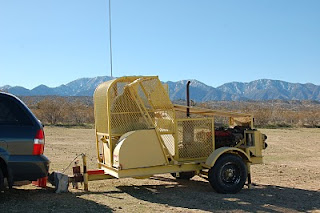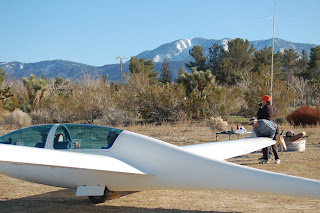Over the last few years our club has developed our winch launching program by refurbishing our winch, by training a number of pilots, and by testing it at several different locations. We have launched the Blanik L13's many times, and the PW5 single-seater several times. Our Grob 103 Twin Astir did not have a center-of-gravity hook, and it was considered pretty heavy and not really a training ship, so we had never winch launched it. The grounding of the Blanik L13 fleet put us on hold for a while, but the club refused to give up. We found out that there is an approved CG hook add-on for our ship, which could be purchased and installed for less than $1,000. It was completed on our ship in mid-January. And some of our mechanically adept members have made improvements to the winch which have increased its power and reliability. The operators of Crystalaire have been open to having us conduct winch launches there. The runway plus dirt extensions add up to about 4500 feet which is plenty long for winch launching. So finally it has all come together. The question remained: how well would

the winch launch the Twin Astir?
So the club organized a "Winch Weekend" at Crystal. I wasn't able to make it Saturday, which was just as well because the winch engine broke down after just two launches. But the crew was able to get the part and fix it early Sunday morning, so we were back in business.
Winds were good, probably 8-10 knot and at just a slight angle to the runway. Our instructor took a solo flight, then did some flights with one of the senior instructors from Crystal. The verdict was in: the combo of our winch and our Grob 103 Twin Astir works
great! It accelerates really well, climbs straight and smooth. The winch has plenty of power, and its shifting of gears is not a problem. Launches were anywhere from 1300' to 1600' in the early flights. We also launched one of Crystal's gliders which I think is about 100 pounds heavier, with a greater wingspan and much better performance, and it got up to 1800'. Wow!
I was next up for a couple of launches with our instructor. If you've been following my blog you'll recall that I have had quite a few winch launches in Blanik L13, and several abortive launches in the PW5. The first few times I winch launched in the Blanik L13 it really got my attention: 0 to 55 in about three seconds, really startling the first time. I expected the heavier G103 would accelerate a little more slowly. Quite the opposite: with our beefed-up winch, the acceleration is even faster. The first one this time actually gave me a bit of a "head rush". I estimate we're now going to 50 or 55 in less than two seconds. I did some back-of-the-envelope calculations, and I think that's between 2.5G and 3G or more of acceleration. To put this in perspective, some of you may be familiar with thrill rides that use linear induction motors to accelerate ride vehicles. The one I'm familiar with is California Screamin' at Disney's California Adventure park. It goes from 0 to 55 in four to five seconds. I think the acceleration of our winch launch is nearly twice that. (I didn't notice the "head rush" effect on later launches.)
Once we were moving, the G103 seemed very sm

ooth and eager to climb. I focused mostly on staying wings-level in the climb. The best climb rate requires having the stick all the way back or nearly so. There's sometimes just a little "porpoising" as the line gets little amounts of slack or as the winch shifts gears, but it's not very noticeable. My first launch was to 1300' AGL. The first thing I noticed after getting off the rope was that it's a little difficult to get one's bearings. During the climb, you can hardly see the ground due to the steep angle. Getting off the line nearly over the winch, the airport is behind and below, and you can't see it until you turn. All you can see is the nearly featureless desert. Once we completed our turn first turn I could see the airport and get reoriented.
On the second launch, we got to 1500' AGL but then the weak link broke. We don't think we pulled on it too hard, because that launch was about the same as the previous 5 or so of the day. It may be that the link was getting weaker with age and use, and it was just its time to break.

My first landing was not as close to the beginning of the dirt touchdown area as my instructor would have liked. Probably I was aiming a little further out because of the proximity of some wires on that end of the runway. The next time I brought it in steeper, established my aiming point closer in, and had a good landing (e.g. we didn't have to pull the glider back quite so far).

My third flight right after that was solo, and the launch went quite normally. I got up to 1400' AGL before releasing. Shortly after turning north I found lift, probably thermal. It was pretty big, and was anywhere from 300 fpm to 700 fpm and fairly consistent. I worked it for just a short while and probably could have soared away. (I spotted a hawk doing some aerobatics below me.) But this was not a day for soaring, since we were trying to get several people experienced with winch launching the Grob. So I came back after just 10 minutes. But I'm convinced that when the weather heats up we'll be able to hook thermals and get away.
A number of other people had instructional launches and short rides. I prepped the PW5 for flight, but it was getting late and we had other priorities, so I'll launch it another day. As it turns out, I flew the G103 once more late in the afternoon, the last flight of the day. One of the Crystal staff wanted to go for a ride (has flown in gliders many times but not had a winch launch). So off we went again. The initial acceleration was a little bumpy, which was new. Later we figured out that as we rotated the ship to line it up for launch, we dug the main wheel into a bit of a hole in the sandy soil. Next time we'll know to push it forward a bit so that it doesn't have the resistance of having to pull out of a hole. Not that it's a problem for the winch - plenty of power there! But it makes the initial roll start with a bump, which you don't need when you're getting to 55 in 2 seconds. Anyway, we got up to 1400' and released. We found a little sustaining lift but it didn't keep us up very long - by this time the sun was getting fairly low in the sky so the thermal was weaker. She had a great time, and we came back after just about 7 minutes. This time I intentionally landed long onto the paved runway (really smoothly, if I may say so), and rolled all the way to the east end of the airport, stopping perfectly in front of our tie-down spot.

I think we had a total of 14 winch launches that day. A good beginning to what we hope will be a new standard operating procedure for the club at this location.